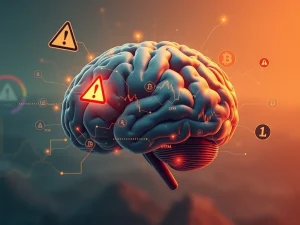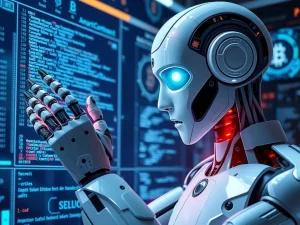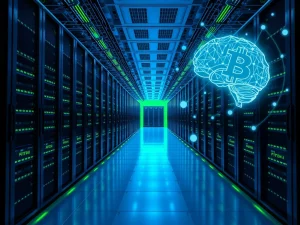Shocking Courtroom Showdown: Judge Slams Defendant’s AI Avatar Legal Appeal
In a bizarre courtroom twist that sounds straight out of a sci-fi movie, a defendant in New York decided to ditch traditional legal representation and instead, rolled out an AI avatar to argue his case during a legal appeal. The result? Let’s just say it didn’t go as planned. Imagine the scene: a serious New York appeals court, solemn proceedings underway, and then… a digital face pops up on screen to represent the defendant. The judge’s reaction was priceless, and not in a good way for the AI-loving defendant.
Judge’s Fury Erupts Over AI Avatar in Legal Appeal
Justice Sallie Manzanet-Daniels of the New York appeals court didn’t mince words when she encountered Jerome Dewald’s attempt to use an AI avatar. Representing himself in an employment dispute, Dewald thought he was being innovative by presenting his arguments via a digitally generated persona. However, within mere seconds of the AI avatar appearing on the livestreamed hearing, the judge halted proceedings. Her immediate question: “Is that avatar counsel for the case?”
Dewald, 74 years old, confirmed that he had “generated” the avatar himself, clarifying, “That is not a real person.” This revelation did not sit well with Justice Manzanet-Daniels. She expressed her displeasure, stating it would have been “nice to know that when you made your application.” The judge highlighted Dewald’s previous appearances in court where he had testified verbally without issue, suggesting the AI stunt was unnecessary and misleading.
“I don’t appreciate being misled,” the judge firmly stated, questioning if Dewald had a medical condition preventing him from speaking. Then, delivering the ultimate courtroom shutdown, she accused Dewald of trying to use the court as a “launch for your business” before emphatically ordering, “Shut that off!” pointing at the offending video screen. The courtroom drama unfolded live on the Appellate Division, First Department Stream, leaving viewers stunned.
Appellate Division, First Department Stream. Source: YouTube
Why Did He Use a Courtroom AI Avatar?
Dewald later apologized for the stunt, explaining his reasoning was to present his arguments more “eloquently” than he felt he could himself. Speaking with The Associated Press, he admitted seeking court permission to play a prerecorded video and then utilizing a San Francisco tech firm to create the courtroom AI avatar. His initial plan to create a digital replica of himself was thwarted by time constraints before the crucial hearing.
“The court was really upset about it,” Dewald confessed, acknowledging, “They chewed me up pretty good.” This incident serves as a stark reminder of the uncharted territory we’re entering as artificial intelligence increasingly intersects with traditional institutions like the legal system.
The Broader Trend: AI in Law and Legal Tech
This legal appeal mishap is not an isolated incident but rather a symptom of a larger trend: the rapid integration of AI into the legal world. Here are some key examples highlighting this growing phenomenon:
- Fake Cases Generated by ChatGPT: In 2023, a New York lawyer faced severe backlash for citing fake legal cases fabricated by ChatGPT in a legal brief. This embarrassing episode underscored the dangers of blindly trusting AI-generated information without human verification in legal contexts.
- Arizona Supreme Court’s AI Avatars: In a contrasting approach, the Arizona Supreme Court began employing two AI-generated avatars in March. These avatars, similar in concept to Dewald’s, are designed to summarize complex court rulings for public consumption, aiming to enhance accessibility and understanding of legal decisions.
- FTC Action Against AI Lawyer Firm: The US Federal Trade Commission (FTC) has been actively clamping down on companies misleading consumers with AI-powered services. This includes a firm offering an “AI lawyer,” suggesting a growing regulatory scrutiny over the promises and realities of AI in legal assistance.
Ethical and Practical Concerns of Courtroom AI
The courtroom AI avatar incident brings forth several critical questions and concerns about the ethical and practical implications of using AI in legal settings. Consider these points:
- Authenticity and Deception: The judge’s immediate reaction highlights a core concern: the potential for deception and misrepresentation. Courts rely on human testimony and presence to assess credibility. An AI avatar blurs these lines and can be perceived as intentionally misleading.
- Due Process and Right to Representation: Does representation by an AI avatar truly fulfill the right to legal representation? Legal proceedings are designed for human interaction, argumentation, and nuanced understanding. An AI, in its current form, may lack the emotional intelligence and adaptability required in complex legal battles.
- Technological Divide and Access to Justice: While some might see AI as democratizing access to legal services, others worry about exacerbating the technological divide. Not everyone has the resources or technical know-how to create or utilize AI avatars for legal representation.
- Data Privacy and Security: Using AI in legal contexts raises serious questions about data privacy and security. Legal proceedings involve sensitive information, and ensuring the security and confidentiality of data processed by AI systems is paramount.
- The Human Element in Justice: Justice is not just about algorithms and data; it’s deeply rooted in human judgment, empathy, and understanding. Over-reliance on AI risks dehumanizing the legal process and potentially undermining public trust in the justice system.
The Future Trajectory of AI in Law
Despite the rocky start for Dewald’s courtroom AI avatar, the integration of artificial intelligence in law is inevitable and potentially transformative. The key lies in responsible implementation and thoughtful consideration of the ethical and practical challenges. Here’s what the future might hold:
- AI as a Legal Tool, Not Replacement: The focus will likely shift towards using AI as a tool to assist lawyers and judges, rather than replacing them entirely. AI can excel at tasks like legal research, document review, and case analysis, freeing up human lawyers to focus on strategy, client interaction, and courtroom advocacy.
- AI for Legal Accessibility: AI-powered tools can enhance access to justice by providing affordable legal information, automating routine legal tasks, and offering preliminary legal advice to those who cannot afford traditional legal services.
- Regulation and Ethical Guidelines: As AI becomes more prevalent in law, expect increased regulatory scrutiny and the development of ethical guidelines to govern its use. This will be crucial to prevent misuse, ensure fairness, and maintain public trust.
- Hybrid Legal Models: The future of law may involve hybrid models that blend human expertise with AI capabilities. This could mean AI-powered legal assistants, AI-augmented judges, and AI-supported legal research platforms, all working in tandem to improve the efficiency and effectiveness of the legal system.
Conclusion: Navigating the AI Legal Frontier
The case of the judge slams AI avatar in a legal appeal serves as a cautionary tale and a wake-up call. While the potential of AI to revolutionize the legal field is undeniable, its implementation must be approached with caution, foresight, and a strong ethical compass. The legal profession, policymakers, and technology developers must collaborate to navigate this frontier responsibly, ensuring that AI serves to enhance justice and fairness, rather than undermining the fundamental principles of the legal system. The courtroom is, after all, a place for human judgment and reasoned argument, and while AI can assist, it should not replace the essential human element at the heart of justice.










